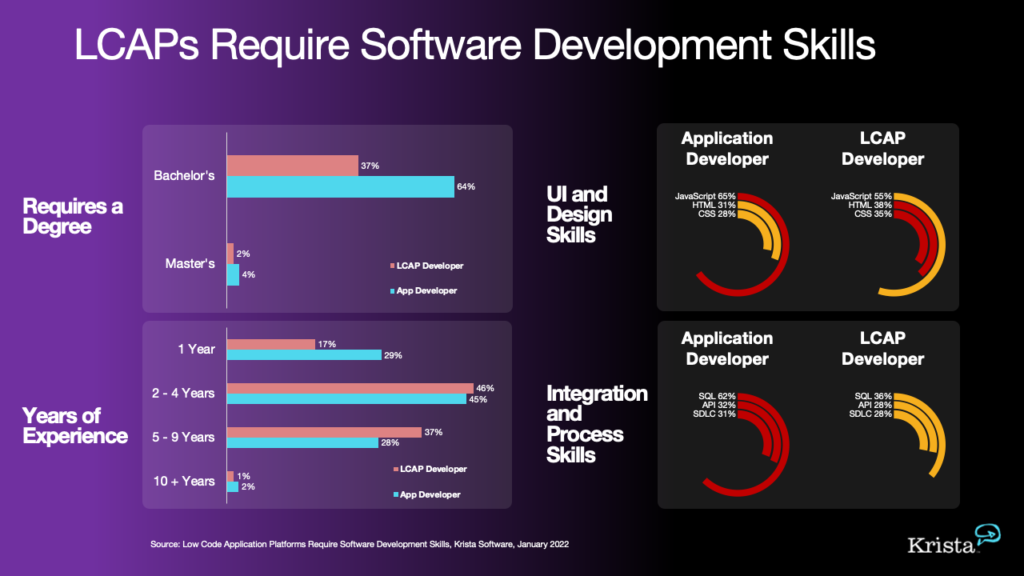Due to a range of factors, Low-code Application Development is accessible to people who are not developers. They are also known as "citizen designers."
Drag-and-Drop Builders: Low-code systems have drag-and-drop interfaces that allow non-developers to design applications without having to write code. This makes the process of development more accessible for people who have little or no technical knowledge.
WYSIWYG editors: These "What You See is What You get" editors let users design interfaces and workflows that look similar to the finished version. This makes it easier to learn and use.
Simplified Design of Workflow Logic and Workflow:
Visual Workflow Modelling: Users are able to develop business procedures, application logic, and flowcharts using diagrams as well as visually-designed flowcharts. These methods are more intuitive than the conventional coding techniques.
Pre-built Logic Components Low-code platforms contain logic components that are pre-built (e.g. conditional loops and statements), which can be easily customized which eliminates the need for complicated coding.
Reusable Components and Templates
Library of Pre-built Templats: Many Low-Code platforms offer templates that are based off of common application types. Developers who are not developers will be capable of modifying these templates, if required.
Reusable Modules and Widgets: Utilizing reusable modules and widgets, users can simplify the design process, while also reducing the requirement for technical knowledge.
Guided Development Tutorials and Guided Development:
Step-by-step guides Platforms provide tutorials, on-screen tips, and guided development paths to assist non-developers in creating applications.
Interactive Tutorials Interactive tutorials are hands-on and interactive that allow users to learn through doing. This improves the confidence of users in the platform.
Integration with existing tools:
seamless integration: Low-code platform are designed to integrate seamlessly with the existing systems, tools, as well as software (e.g. ERP, CRM, ERP). This enables non-programmers with no experience in programming to create applications that are compatible seamlessly with their current workflows.
APIs and Connectors: APIs integrated into connectors and APIs enable non-developers and users to easily connect applications with external services without the need for complicated programming.
Collaboration Features:
Team Collaboration - Features like real-time team collaboration, and shared workspaces enable non-developers to work effectively alongside analysts, professionals, developers, and others.
Role Based Access Control: You can give non-developers certain roles that have the right access level so that they can participate in the development process while not compromise on security or function.
Automated Testing and Debugging
Built-In Testing Tools: Low-code platforms often come with built-in testing and debugging tools to automate these procedures, making it simpler for non-developers to make sure the application is working properly.
Error Highlighting Whenever errors are detected the platform highlights these and suggests possible fixes. It helps non-developers in solving the issue.
The main benefit of developing applications using low-code in terms of accessibility for non-developers is its capacity to make development more accessible. Platforms that use low-code empower business users by offering them easy-to-use, visual and guidance tools. They are then able to actively take part in the process of developing and maintaining applications. See the top rated read full report for Low-code Platform for application development for site advice including app modernisation, rad development, app modernisation, database in azure, app platforms, sso azure, rapid applications, jdbc server, rapid app development, cross platform app development and more.

Flexibility And Scalability Are Two Advantages Of Low-Code Application Development
Low-code applications have a number of advantages when it comes to scalability. They are scalable and flexible, and they can be adjusted to accommodate new needs. Here are the key advantages: Rapid Scaling
Cloud-Based Deployment: A lot of low-code platforms are cloud-based, enabling applications to scale effortlessly with the cloud infrastructure. This lets companies handle increasing loads without worrying over managing servers.
Auto-Scaling: This feature can automatically adjust the resources in accordance with the demands. This ensures consistent performance at peak times with no manual intervention.
Flexible Architecture:
Modular Application Design: The low-code platform encourages modular design of applications. Components are able to be independently evaluated, designed and expanded. This modularity improves flexibility and facilitates upgrades or expansions of certain parts without impacting the whole system.
Microservices Integration : In support of microservices architecture, applications may be developed using loosely-coupled services to increase both flexibility and scalability.
Customizable Solutions
Extensibility: Low-code platforms typically allow custom scripting and coding, which lets developers expand the capabilities of apps beyond the ones that are available. This allows the satisfaction of business needs that are unique without limitations.
Third-Party Integrations: Integration to third-party APIs and services enables companies to add more functionality to their application.
Agile Development & Deployment
Continuous Delivery and Deployment: Low-code platforms can be used to implement agile methods, enabling continuous integration and continuous delivery (CI/CD). This allows for the rapid release of updates and new features, assuring that the applications are able to evolve rapidly in response to feedback from users and market changes.
Iterative development: Low-code development is iterative meaning that applications can be scaled and developed incrementally. This decreases the risk of major changes and allows an controlled growth.
Resource Optimization:
Low-code platforms provide tools to track and manage the performance of an application and help maximize the utilization of resources. This ensures that resources are efficiently used and can be scaled up or down according to actual demands.
Load balancing: The application is able to handle large volumes of traffic with ease and consistency thanks to the integrated load-balancing capabilities.
Global Reach:
Multi-Region Deployment: Low-code systems typically support deployment across several geographical regions, allowing businesses to provide low-latency access to users around the world. This is especially important for apps that have a global user base.
Support for Localization The built-in support for localization allows the applications to be easily tailored for different languages and requirements in diverse markets.
Updates and maintenance
Simplified maintenance: The graphic and module design of low-code applications makes it easier to complete the maintenance tasks. They allow updates and bug corrections to be carried out quickly without extensive downtime.
Version Control: The integrated system for controlling version allows the safe deployment of rollbacks and updates. Versions from the past can be restored if they're required.
Cost Efficiency:
Low Development Costs - Through decreasing the amount of programming needed, low-code platforms can cut down on development costs. This makes it possible to increase the size of applications without needing to increase the development effort and expenditure.
Pay-As.-You-Go: Many lowcode platforms offer flexible price models, such as pay-as.-you-go. These models align costs to actual usage and growth, allowing financial flexibility.
In general, low-code app developers offer a high level of flexibility and scalability which allows businesses to quickly build scalable and flexible applications. These platforms can quickly adapt to changes in demand, make efficient use of resources, and continuously enhance, allowing both applications and companies alike to grow and grow. See the top rated the full details for Legacy application modernization with Low-code for more info including cross platform mobile app development, develop web app, application modernization, application modernisation, develop mobile application, database in azure, push notifications android, cloud software applications, push alerts, cross platform mobile dev and more.

Benefits Of Developing Applications Using Low-Code In Terms Of Collaboration And Workflow
Low-code app development is an excellent option for businesses looking to increase team efficiency through streamlining development processes. Here are some of the benefits that are most notable: Improved cross-functional collaboration:
Unified Development Environment: Low-code platforms provide a single, unified environment where team members comprising business analysts, developers designers, and other stakeholders, can collaborate effectively. This eliminates barriers and improve communication.
Visual Development The platform's visual drag-anddrop capabilities make it easy for non-technical team members to contribute in the process of design. It also ensures that business needs are properly documented and implemented.
Communication Enhancement:
Real-Time Collaboration Many low-code platforms have real-time features such as commenting and editing simultaneously, or instant feedback. This allows for constant communication and can help reduce the time that is spent on back-and-forth discussions.
Workspaces shared by teams. Teams can collaborate in shared workspaces. There, they are able to view, edit and discuss various project components.
The streamlining of workflow management
Project management tools that are built-in Low-code platforms typically come with project management tools that allow teams to organize, track and manage their projects. This includes task assignment tracking progress, task assignment, and deadlines management.
Workflow Automation Automating repetitive tasks as well as workflows will reduce errors and effort and allow employees to focus on the strategic tasks while increasing efficiency.
More frequent iteration cycles:
Rapid Prototyping: Low-code platforms allow rapid prototyping and iterative design which allows teams to create prototypes, test, and refine applications over shorter periods of time. This ensures feedback can be quickly integrated and changes can be made.
Support for agile development: Supporting agile practices allows teams to collaborate continuously during sprints. This makes it easier to change and deliver smaller incremental improvements to functionality.
Accessibility of Non-Developers
Citizen Development: Low code platforms allow business users (citizens developers) to create and modify applications, without any prior knowledge of programming. This eases the workload on IT teams as well as developers, allowing them to respond faster to the demands of business.
Training and onboarding: Simple user interfaces and extensive resources for training aid in bringing new team members up to speed. This improves the overall cohesion of the team.
Centralized documentation, knowledge sharing and dissemination:
Low-code platforms typically include features for creating, maintaining and storing documentation within their platforms. This allows the entire project's information to be centrally stored and easily accessible.
Knowledge Repositories: Teams are able to develop and keep knowledge repositories, which include best practices, templates, and reuseable components, helping to facilitate sharing of knowledge and reducing the duplication of effort.
Consistency in Standardization:
Standardized Components. The commonality of components across various applications assures uniformity, which makes it simpler to work with and understand by team members.
Governance and compliance Governance and compliance frameworks that are built-in to assure that all applications are designed in accordance with organizational standards, regulatory requirements and standards for quality. They lower the risk of not adhering to regulations and assure that the application meets the requirements of the standards.
Feedback and Improvement Loops
Integrated Feedback Platforms with Low-Code provide users with feedback mechanisms integrated into them that allow them to provide feedback easily on applications. The feedback is later integrated into the application development process.
Continuous Improvement: The capacity to quickly test and deploy modifications based on feedback assures that applications are continuously enhanced, and are in line with the needs and objectives of the users.
Visualization of Reporting:
Real-Time Analyses: The built-in reporting and analytics tools provide real-time insight into the project's performance, development and user interactions, which allows for data-driven decisions.
Visual Workflow Mapping Visual tools for mapping processes and workflows help teams understand and optimize their workflows, while identifying the areas of improvement and bottlenecks.
Low-code development has many advantages in regards to workflow and collaboration. It allows for the integration of diverse teams together, automate processes, streamline communication and improve teamwork. This fosters a team-oriented environment with an agile and efficient development process that results in higher-quality apps and a more effective alignment between the business goals.
